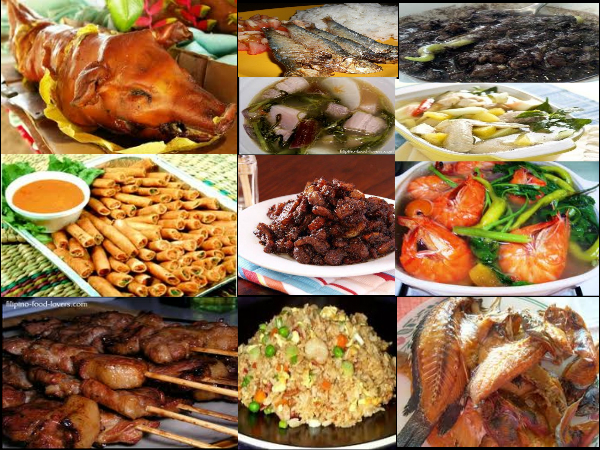 Eating Habits & Hospitality
Eating Habits & Hospitality
Filipinos love to eat, and since they’re naturally hospitable and gregarious, food is the basis of their social life. Because the feeling of fulfillment after eating rice, their staple ingredient, is relatively short-lived, they eat three meals a day and two snacks in between. Filipinos, especially country folk, rise early. Some will eat a segundo almuerzo (second breakfast) around 10:30, plus a merienda, or mid-afternoon snack. Rural folk eat their main meal at midday, while city dwellers emphasize the evening meal. The diet of poor families is usually rice, fish, vegetables, interspersed with starchy snacks. At fiesta time, all families try to eat meat.
Since few provincial households own a refrigerator, ingredients are customarily either fresh or salted. Housewives go to the market daily to buy their immediate requirements. Leftovers rarely remain after a meal. Extra food is eaten by servants, helpers, and hangers-on, and scraps go to the dog or pig. Food isn’t served in courses; people like the complete meal laid out before them so that they can eat simultaneously from all dishes—soup, meat, and vegetables—at random. Cooks provide condiments, flavorings, and dipping sauces to be used at the diner’s discretion. Food is eaten with a fork in one hand and a spoon in the other, knives are seldom used. Rural Filipinos prefer to use their hands. Some upscale native restaurants in Manila serve food this way (kamayan-style).
Hospitality
A stranger passing Filipinos who are eating will automatically be invited to “come and eat.” It’s polite to say you’ve already eaten. If people insist, or if there’s an abundance of food such as at a wedding or fiesta, then by all means participate. Don’t accept the first invitation. It’s better to point out how inconvenient it would be for the host, or to make a polite excuse, then wait to see if you’re pressed further. It’s the Filipino way, enabling the visitor to gauge whether an invitation is genuine or not.
Travelers should always take into account the reverence Filipinos have for food. Regular mealtimes are strictly observed. When visiting a home, you’ll be offered food and drink. It’s polite to wait to be urged to sit at the table or begin eating. If you don’t like the food, eat a little and make an excuse rather than reject it outright. Guests leave a little food on the plate to indicate they’re satisfied.
Background
Like the culture in general, Filipino food is basically of Malay origin, with Spanish, Chinese, and American influences. Regardless of origin, lechon, lumpia, and pork adobo are now considered national dishes. Regional variations in the fresh ingredients available account for provincial specialties. Centuries of Spanish rule have resulted in about 80% of Filipino dishes being of Spanish derivation. Interestingly, there was relatively little Mexican influence, despite the ties to a Mexican-based administration and the galleon trade. The Spanish colonialists preferred Iberian dishes, such as arroz valenciana, to those of the Mexican Indians. Adobo preparation is the only exception as the tomato, corn, avocado, and potato in adobo were all introduced from Mexico.
The most obvious Chinese contribution is noodles, which form the basis of the popular pancit dishes. The Chinese also gave the Philippines lumpia and chop suey. Some standard dishes, such as the coconut-based ginataan, have retained their Malay origin. The Muslims never entered the Spanish sphere, so their cooking has remained heavily Malay. It’s spicy, and marked by the use of coconut milk and chilis, the prevalence of cassava as well as rice and seafood, and the absence of pork.
The Appetizer
Philippine cuisine has been influenced by Chinese, Malay, Spanish, Mexican, American, and Indian cooking. The staple of Filipino food is rice, usually served with pig, seafood, chicken, and/or native fruits, and the ever-present dipping sauces
Appetizers in the Filipino cuisine are also known as “hand food”, called pulutan. The pulutan are served most often with liquors and non-alcoholic beverages, and will be offered in restaurants as well as local dinners, not matter the country’s region. There are different types of pulatan including fish, meat, nuts and chips. Some of the most delicious appetizers include Filipino Satays marinated in a special blend, steamed meatballs sealed in wonton wrappers and dipped in soy sauce with squeezed kalamansi (Philippine lemon). This particular appetizer is influenced from the Chinese cuisine, but served in a particular Philippines manner. There is also the grilled chicken feet, spicy fried peanuts, sometimes flavored with garlic, salted, dried and fried pork rind, or the tiny fried spring rolls filled with minced meat. Appetizers in the Filipino cuisine are served before dinner or at big family lunches, and most of them are home made and have differences in the condiments added, like the sisig, minced pig’s cheeks cooked with herbs and spices, according to the cooks personal preferences.
Popular Filipino appetizers include:

Hi, this is a comment.
To delete a comment, just log in, and view the posts’ comments, there you will have the option to edit or delete them.
i’m hungry…